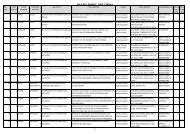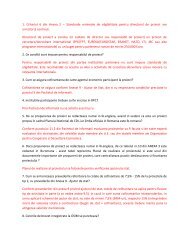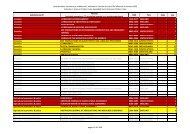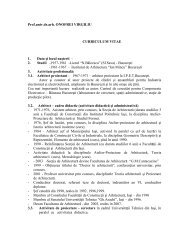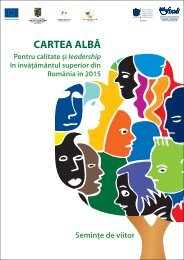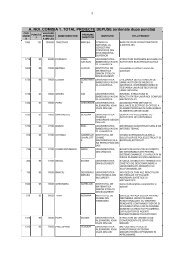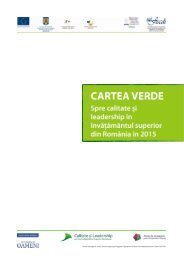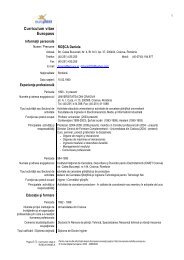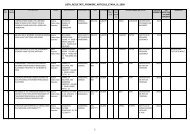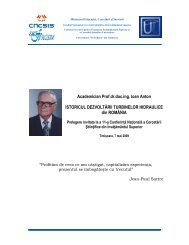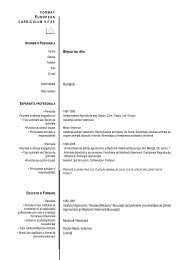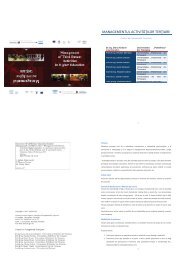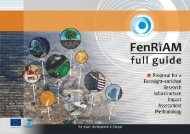Modul de formare-Managementul resurselor financiare - uefiscdi
Modul de formare-Managementul resurselor financiare - uefiscdi
Modul de formare-Managementul resurselor financiare - uefiscdi
- No tags were found...
Create successful ePaper yourself
Turn your PDF publications into a flip-book with our unique Google optimized e-Paper software.
Generally, the public funds planned for stu<strong>de</strong>nts are allocated according to regulatory<br />
standards. The scoring for the standards used in the funding mo<strong>de</strong>l varies between 1.0 and<br />
4.7. The scores reflect the differences in the programs cost for different disciplines. At<br />
university level, five equivalents are used while at postgraduate level are used three different<br />
tariffs and two at the university research level.<br />
The total budget allocated to the higher education is a macro pre<strong>de</strong>termined budget. The<br />
financing for universities, including investment and research funds are allocated as a global<br />
amount for the entire set of aca<strong>de</strong>mic activities. The performance indicators are used only for<br />
the research component. The education financing is based entirely on inputs.<br />
The operating grants for universities inclu<strong>de</strong> also, funds for research. These take into<br />
consi<strong>de</strong>ration the income from research (60%), the stu<strong>de</strong>nts engaged in research (30%) and<br />
publications (10%). Since 2003 there are consi<strong>de</strong>red three more types of outputs: permits<br />
(licenses), arbitration projects and expositions.<br />
In addition to the research funds allocated through operational grants, the Australian<br />
Government provi<strong>de</strong>s additional resources for research on a project basis. A part of these funds<br />
is distributed by the Australian Research Council, currently a second form of research funding<br />
(providing about 6% of university revenues).<br />
The trends of the Australian system of funding in higher education are directed towards the<br />
vouchers system, the stu<strong>de</strong>nts obtaining vouchers that can be marketed for the educational<br />
services. In this system of financing, the consumer coordinates the system, which is being<br />
oriented towards <strong>de</strong>mand.<br />
1.4. The funding strategy of the public higher education institutions in Romania<br />
In the first 5-6 years of the period after 1990, on one hand, the financing of higher education<br />
institutions has been removed from local budgets and the ministries, and on the other hand, the<br />
funding sources outsi<strong>de</strong> the budget have been expan<strong>de</strong>d by micro-budget activities and services,<br />
introduction of fees, scientific research, foreign loans, etc..<br />
Despite the diversification of the outsi<strong>de</strong> budget sources, their share in the revenue and<br />
expenditure budgets <strong>de</strong>creased first of all, due to contraction of the activity of micro-production<br />
and research, but also due the lack of control over the record and ways on how these revenues<br />
are spent. In real terms, the volume of budget appropriations has <strong>de</strong>creased also with a negative<br />
effect, materialized in the evolution of the average costs per stu<strong>de</strong>nt.<br />
The changes that occurred in the financing of Romanian education system, was strongly<br />
influenced by the increased number of higher education institutions, and thus the number of<br />
stu<strong>de</strong>nts. The number of the higher education institutions is 2.9 times higher in 2009 compared<br />
to 1990, and the number of stu<strong>de</strong>nts has tripled.<br />
Between 1997-2000 it has been <strong>de</strong>veloped a reform program to complete the transition, to link<br />
the education system to the needs and the traditions of Romania and make it compatible with<br />
European references. As a result, at the end of 2000, Romania presents a legislation, institutions<br />
and educational policies consistent with those of European Community.<br />
In 1999 it has passed to the global funding of universities, which drew their financial<br />
autonomy and their connection to the international system.The administrative and aca<strong>de</strong>mic<br />
management have been <strong>de</strong>lineated in the mo<strong>de</strong>rn sense. It switched to funding from multiple<br />
resources of the universities in line with European trends.<br />
12



